Peugeot Bipper 2008 Owner's Manual
Manufacturer: PEUGEOT, Model Year: 2008, Model line: Bipper, Model: Peugeot Bipper 2008Pages: 131, PDF Size: 1.44 MB
Page 101 of 131
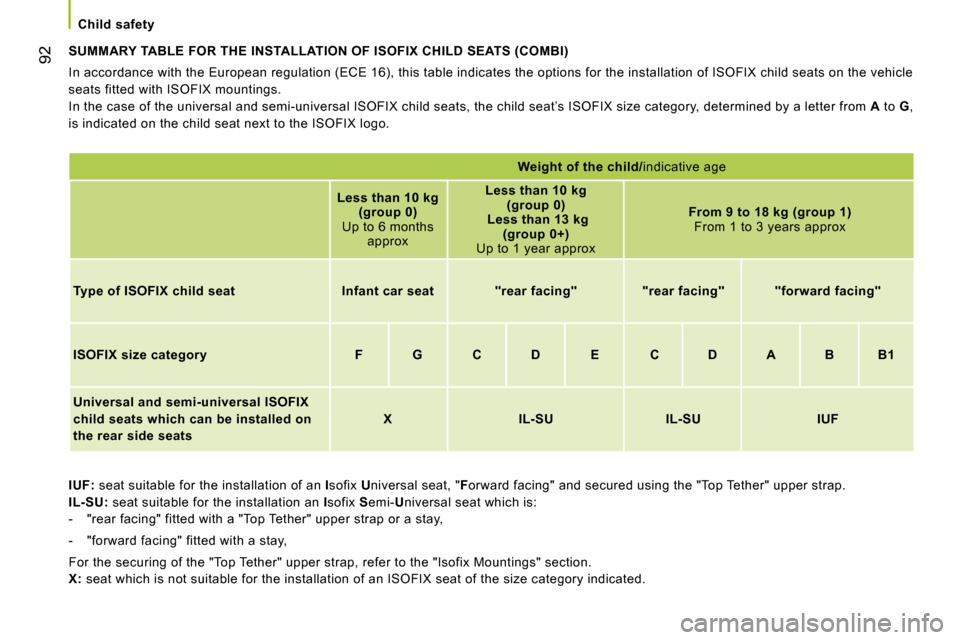
92
Child safety
SUMMARY TABLE FOR THE INSTALLATION OF ISOFIX CHILD SEATS (COMBI)
In accordance with the European regulation (ECE 16), this table indicates the options for the installation of ISOFIX child seats on the vehicle
seats fitted with ISOFIX mountings.
In the case of the universal and semi-universal IS OFIX child seats, the child seat’s ISOFIX size cate gory, determined by a letter from A to G ,
is indicated on the child seat next to the ISOFIX l ogo.
IUF: seat suitable for the installation of an I sofix U niversal seat, " F orward facing" and secured using the "Top Tether" upper strap.
IL-SU: seat suitable for the installation an I sofix S emi- U niversal seat which is:
- "rear facing" fitted with a "Top Tether" uppe r strap or a stay,
- "forward facing" fitted with a stay,
For the securing of the "Top Tether" upper strap, refer to the "Isofix Mountings" section.
X: seat which is not suitable for the installation o f an ISOFIX seat of the size category indicated.
Weight of the child/ indicative age
Less than 10 kg
(group 0)
Up to 6 months approx
Less than 10 kg
(group 0)
Less than 13 kg
(group 0+)
Up to 1 year approx
From 9 to 18 kg (group 1)
From 1 to 3 years approx
Type of ISOFIX child seat Infant car seat "rear facing" "rear facing" "forward facing"
ISOFIX size category F G C D E C D A B B1
Universal and semi-universal ISOFIX
child seats which can be installed on
the rear side seats
X IL-SU IL-SU IUF
Page 102 of 131
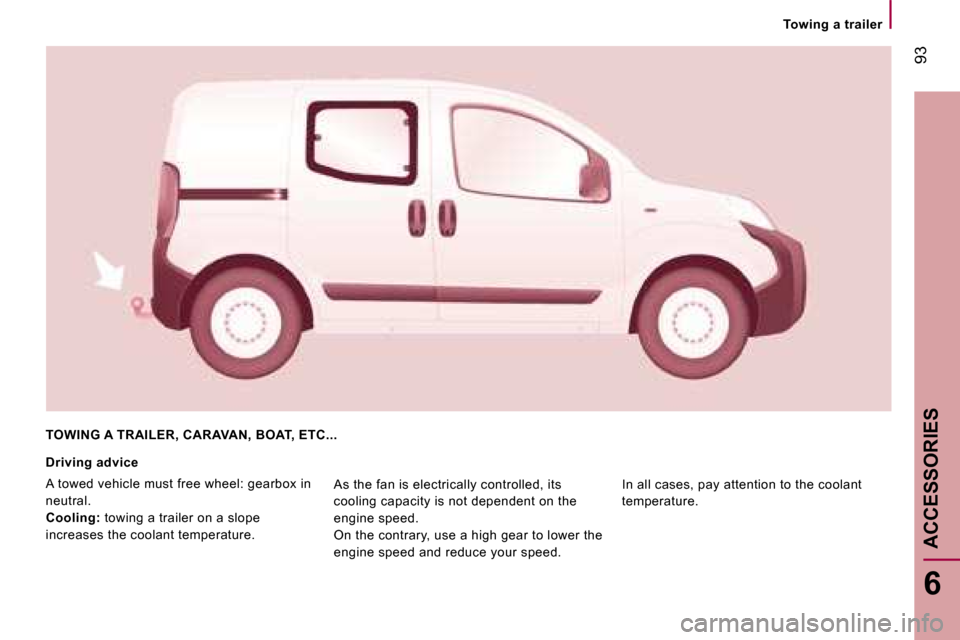
93
6
ACCESSORIES
Towing a trailer
TOWING A TRAILER, CARAVAN, BOAT, ETC...
Driving advice
A towed vehicle must free wheel: gearbox in
neutral.
Cooling: towing a trailer on a slope
increases the coolant temperature. As the fan is electrically controlled, its
cooling capacity is not dependent on the
engine speed.
On the contrary, use a high gear to lower the
engine speed and reduce your speed. In all cases, pay attention to the coolant
temperature.
Page 103 of 131
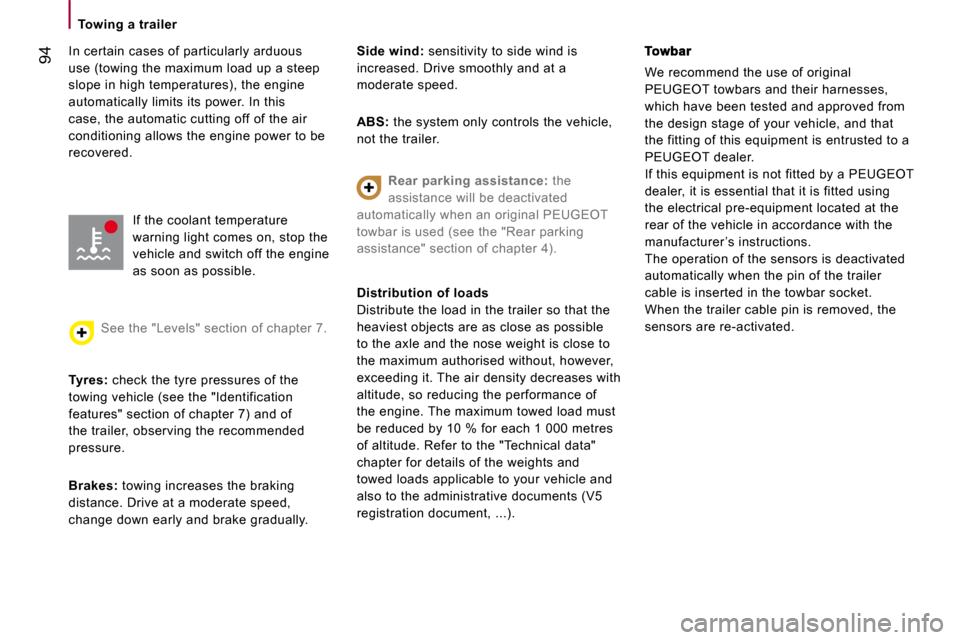
94
Towing a trailer
In certain cases of particularly arduous
use (towing the maximum load up a steep
slope in high temperatures), the engine
automatically limits its power. In this
case, the automatic cutting off of the air
conditioning allows the engine power to be
recovered. If the coolant temperature
warning light comes on, stop the
vehicle and switch off the engine
as soon as possible.
See the "Levels" section of chapter 7.
Tyres: check the tyre pressures of the
towing vehicle (see the "Identification
features" section of chapter 7) and of
the trailer, observing the recommended
pressure.
Brakes: towing increases the braking
distance. Drive at a moderate speed,
change down early and brake gradually.
Side wind: sensitivity to side wind is
increased. Drive smoothly and at a
moderate speed.
ABS: the system only controls the vehicle,
not the trailer.
Rear parking assistance: the
assistance will be deactivated
automatically when an original PEUGEOT
towbar is used (see the "Rear parking
assistance" section of chapter 4).
We recommend the use of original
PEUGEOT towbars and their harnesses,
which have been tested and approved from
the design stage of your vehicle, and that
the fitting of this equipment is entrusted to a
PEUGEOT dealer .
If this equipment is not fitted by a PEUGEOT
dealer , it is essential that it is fitted using
the electrical pre-equipment located at the
rear of the vehicle in accordance with the
manufacturer ’s instructions.
The operation of the sensors is deactivated
automatically when the pin of the trailer
cable is inserted in the towbar socket.
When the trailer cable pin is removed, the
sensors are re-activated.
Distribution of loads
Distribute the load in the trailer so that the
heaviest objects are as close as possible
to the axle and the nose weight is close to
the maximum authorised without, however,
exceeding it. The air density decreases with
altitude, so reducing the performance of
the engine. The maximum towed load must
be reduced by 10 % for each 1 000 metres
of altitude. Refer to the "Technical data"
chapter for details of the weights and
towed loads applicable to your vehicle and
also to the administrative documents (V5
registration document, ...).
Page 104 of 131
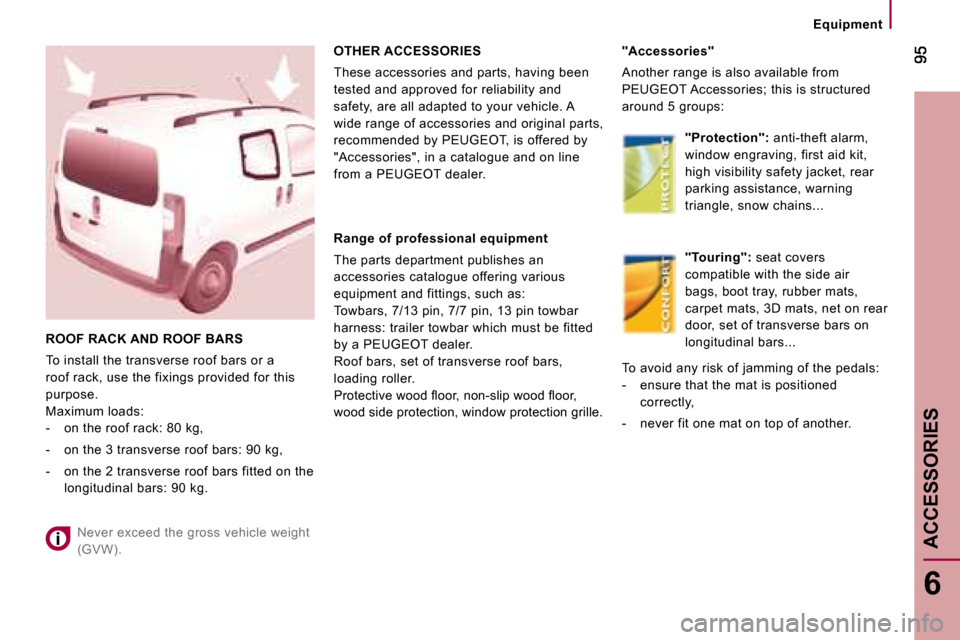
6
ACCESSORIES
Equipment
"Touring": seat covers
compatible with the side air
bags, boot tray, rubber mats,
carpet mats, 3D mats, net on rear
door, set of transverse bars on
longitudinal bars...
To avoid any risk of jamming of the pedals:
- ensure that the mat is positioned correctly,
- never fit one mat on top of another.
ROOF RACK AND ROOF BARS
To install the transverse roof bars or a
roof rack, use the fixings provided for this
purpose.
Maximum loads:
- on the roof rack: 80 kg,
- on the 3 transverse roof bars: 90 kg,
- on the 2 transverse roof bars fitted on the longitudinal bars: 90 kg.
OTHER ACCESSORIES
These accessories and parts, having been
tested and approved for reliability and
safety, are all adapted to your vehicle. A
wide range of accessories and original parts,
recommended by PEUGEOT , is offered by
"Accessories", in a catalogue and on line
from a PEUGEOT dealer.
Range of professional equipment
The parts department publishes an
accessories catalogue offering various
equipment and fittings, such as:
Towbars, 7/13 pin, 7/7 pin, 13 pin towbar
harness: trailer towbar which must be fitted
by a PEUGEOT dealer.
Roof bars, set of transverse roof bars,
loading roller.
� �P�r�o�t�e�c�t�i�v�e� �w�o�o�d� �fl� �o�o�r�,� �n�o�n�-�s�l�i�p� �w�o�o�d� �fl� �o�o�r�,�
wood side protection, window protection grille.
"Accessories"
Another range is also available from
PEUGEOT Accessories; this is structured
around 5 groups:
"Protection": anti-theft alarm,
window engraving, first aid kit,
high visibility safety jacket, rear
parking assistance, warning
triangle, snow chains...
Never exceed the gross vehicle weight
(GVW).
Page 105 of 131
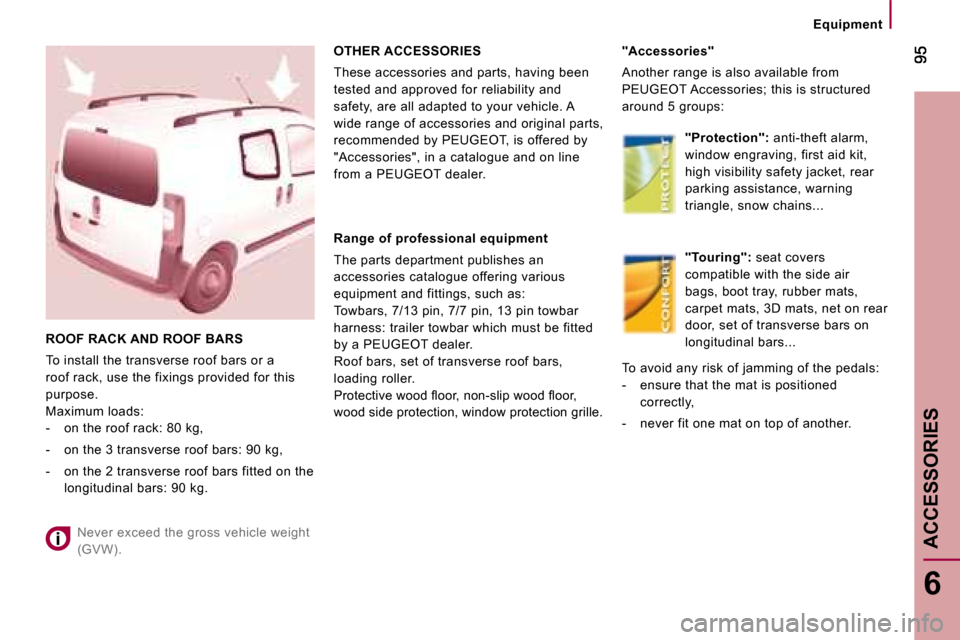
6
ACCESSORIES
Equipment
"Touring": seat covers
compatible with the side air
bags, boot tray, rubber mats,
carpet mats, 3D mats, net on rear
door, set of transverse bars on
longitudinal bars...
To avoid any risk of jamming of the pedals:
- ensure that the mat is positioned correctly,
- never fit one mat on top of another.
ROOF RACK AND ROOF BARS
To install the transverse roof bars or a
roof rack, use the fixings provided for this
purpose.
Maximum loads:
- on the roof rack: 80 kg,
- on the 3 transverse roof bars: 90 kg,
- on the 2 transverse roof bars fitted on the longitudinal bars: 90 kg.
OTHER ACCESSORIES
These accessories and parts, having been
tested and approved for reliability and
safety, are all adapted to your vehicle. A
wide range of accessories and original parts,
recommended by PEUGEOT , is offered by
"Accessories", in a catalogue and on line
from a PEUGEOT dealer.
Range of professional equipment
The parts department publishes an
accessories catalogue offering various
equipment and fittings, such as:
Towbars, 7/13 pin, 7/7 pin, 13 pin towbar
harness: trailer towbar which must be fitted
by a PEUGEOT dealer.
Roof bars, set of transverse roof bars,
loading roller.
� �P�r�o�t�e�c�t�i�v�e� �w�o�o�d� �fl� �o�o�r�,� �n�o�n�-�s�l�i�p� �w�o�o�d� �fl� �o�o�r�,�
wood side protection, window protection grille.
"Accessories"
Another range is also available from
PEUGEOT Accessories; this is structured
around 5 groups:
"Protection": anti-theft alarm,
window engraving, first aid kit,
high visibility safety jacket, rear
parking assistance, warning
triangle, snow chains...
Never exceed the gross vehicle weight
(GVW).
Page 106 of 131
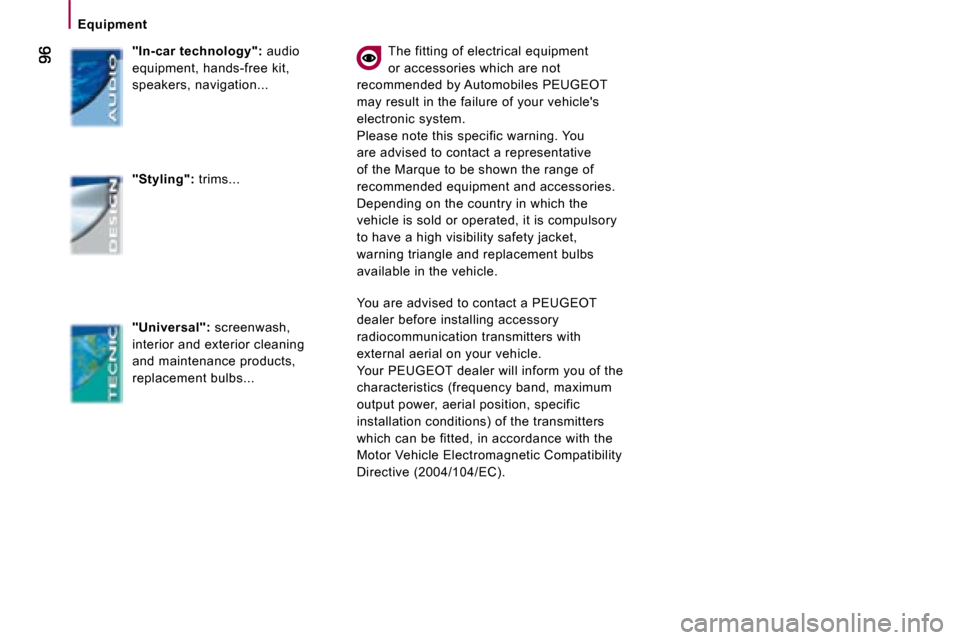
Equipment
"In-car technology": audio
equipment, hands-free kit,
speakers, navigation...
"Styling": trims...
"Universal": screenwash,
interior and exterior cleaning
and maintenance products,
replacement bulbs... The fitting of electrical equipment
or accessories which are not
recommended by Automobiles PEUGEOT
may result in the failure of your vehicle's
electronic system.
Please note this specific warning. You
are advised to contact a representative
of the Marque to be shown the range of
recommended equipment and accessories.
Depending on the country in which the
vehicle is sold or operated, it is compulsory
to have a high visibility safety jacket,
warning triangle and replacement bulbs
available in the vehicle.
You are advised to contact a PEUGEOT
dealer before installing accessory
radiocommunication transmitters with
external aerial on your vehicle.
Your PEUGEOT dealer will inform you of the
characteristics (frequency band, maximum
output power, aerial position, specific
installation conditions) of the transmitters
which can be fitted, in accordance with the
Motor Vehicle Electromagnetic Compatibility
Directive (2004/104/EC).
Page 107 of 131
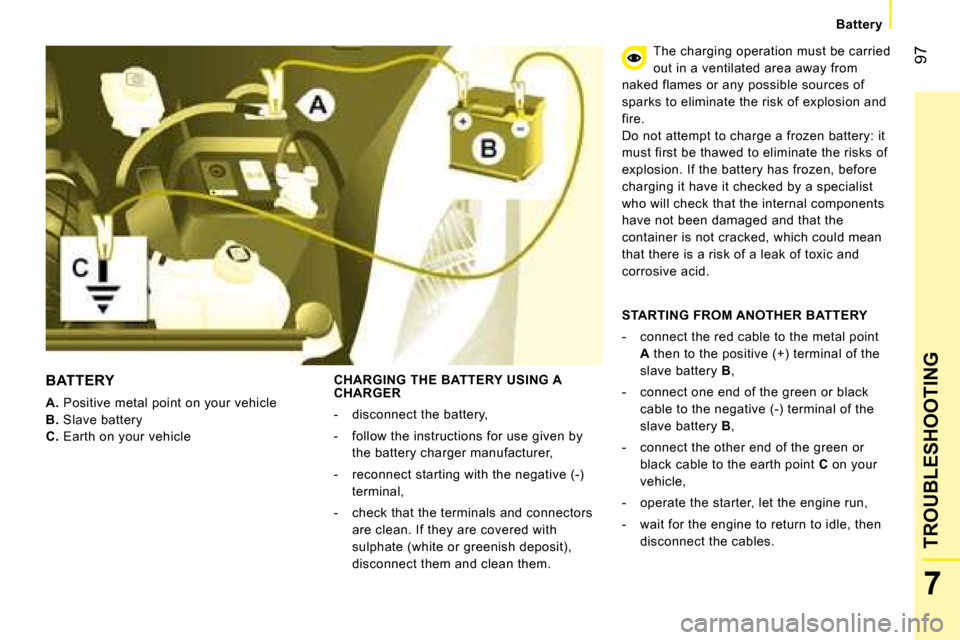
97
7
TROUBLESHOOTING
Battery
BATTERY
A. Positive metal point on your vehicle
B. Slave battery
C. Earth on your vehicle
CHARGING THE BATTERY USING A CHARGER
- disconnect the battery,
- follow the instructions for use given by
the battery charger manufacturer,
- reconnect starting with the negative (-) terminal,
- check that the terminals and connectors are clean. If they are covered with
sulphate (white or greenish deposit),
disconnect them and clean them. The charging operation must be carried
out in a ventilated area away from
naked flames or any possible sources of
sparks to eliminate the risk of explosion and
fire.
Do not attempt to charge a frozen battery: it
must first be thawed to eliminate the risks of
explosion. If the battery has frozen, before
charging it have it checked by a specialist
who will check that the internal components
have not been damaged and that the
container is not cracked, which could mean
that there is a risk of a leak of toxic and
corrosive acid.
STARTING FROM ANOTHER BATTERY
- connect the red cable to the metal point
A then to the positive (+) terminal of the
slave battery B ,
- connect one end of the green or black cable to the negative (-) terminal of the
slave battery B ,
- connect the other end of the green or black cable to the earth point C on your
vehicle,
- operate the starter, let the engine run,
- wait for the engine to return to idle, then disconnect the cables.
Page 108 of 131
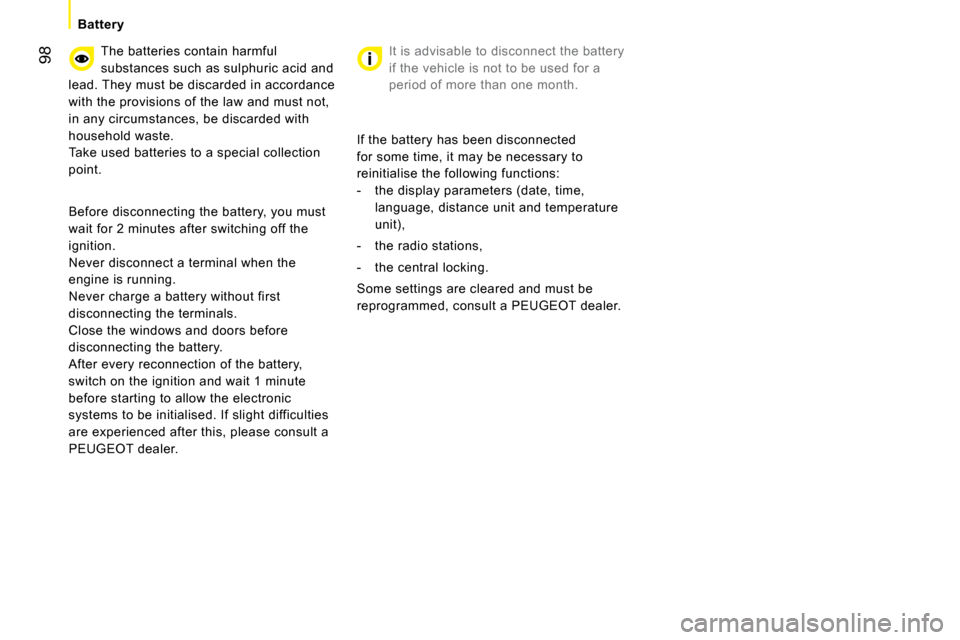
98
Battery
The batteries contain harmful
substances such as sulphuric acid and
lead. They must be discarded in accordance
with the provisions of the law and must not,
in any circumstances, be discarded with
household waste.
Take used batteries to a special collection
point.
Before disconnecting the battery, you must
wait for 2 minutes after switching off the
ignition.
Never disconnect a terminal when the
engine is running.
Never charge a battery without first
disconnecting the terminals.
Close the windows and doors before
disconnecting the battery.
After every reconnection of the battery,
switch on the ignition and wait 1 minute
before starting to allow the electronic
systems to be initialised. If slight difficulties
are experienced after this, please consult a
PEUGEOT dealer . It is advisable to disconnect the battery
if the vehicle is not to be used for a
period of more than one month.
If the battery has been disconnected
for some time, it may be necessary to
reinitialise the following functions:
- the display parameters (date, time, language, distance unit and temperature
unit),
- the radio stations,
- the central locking.
Some settings are cleared and must be
reprogrammed, consult a PEUGEOT dealer .
Page 109 of 131
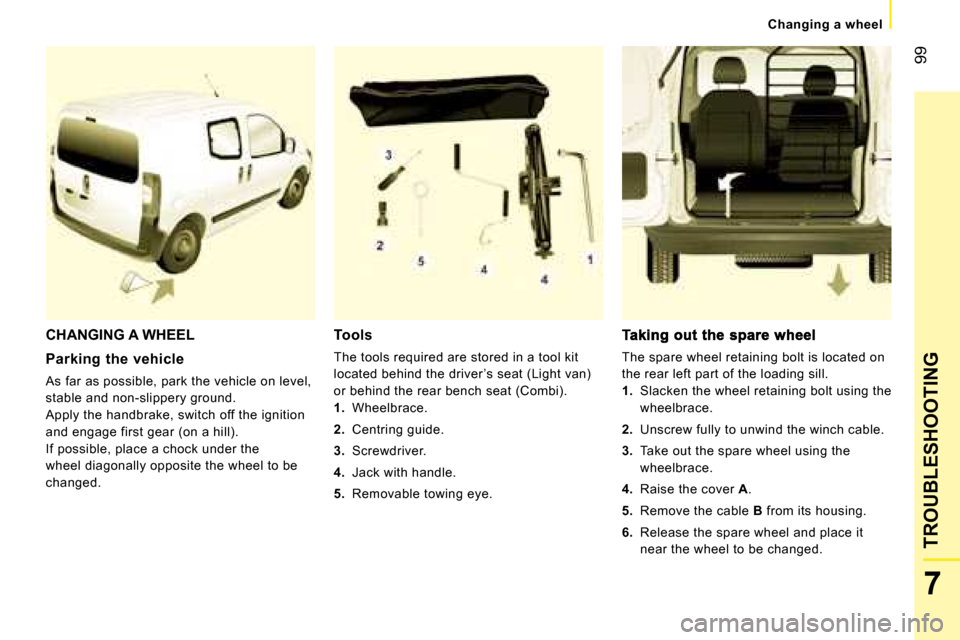
99
7
TROUBLESHOOTING
Changing a wheel
CHANGING A WHEEL
Parking the vehicle
As far as possible, park the vehicle on level,
stable and non-slippery ground.
Apply the handbrake, switch off the ignition
and engage first gear (on a hill).
If possible, place a chock under the
wheel diagonally opposite the wheel to be
changed.
Tools
The tools required are stored in a tool kit
located behind the driver ’s seat (Light van)
or behind the rear bench seat (Combi).
1. Wheelbrace.
2. Centring guide.
3. Screwdriver.
4. Jack with handle.
5. Removable towing eye. The spare wheel retaining bolt is located on
the rear left part of the loading sill.
1. Slacken the wheel retaining bolt using the
wheelbrace.
2. Unscrew fully to unwind the winch cable.
3. Take out the spare wheel using the
wheelbrace.
4. Raise the cover A .
5. Remove the cable B from its housing.
6. Release the spare wheel and place it
near the wheel to be changed.
Page 110 of 131
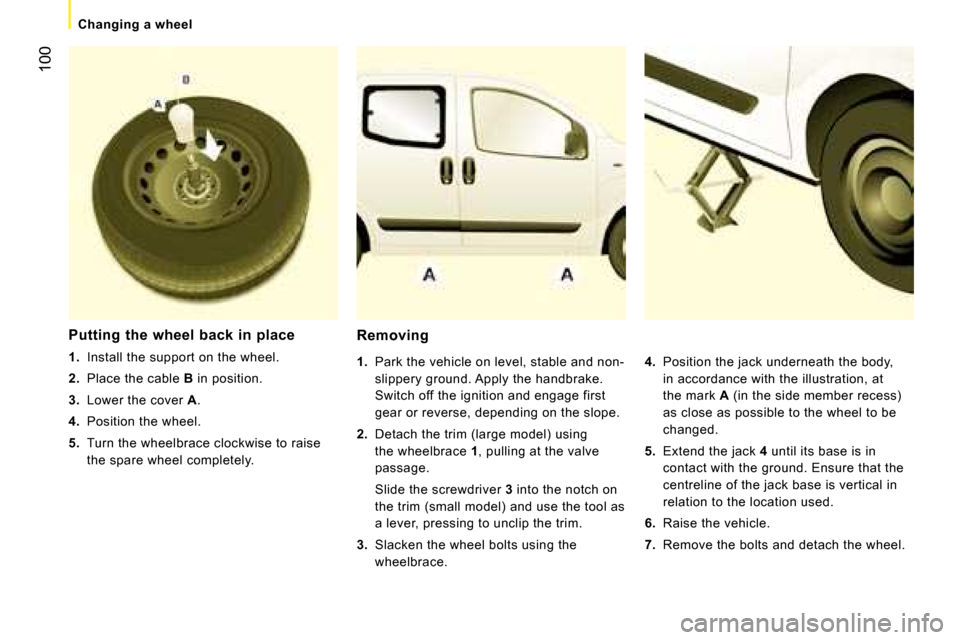
100
Changing a wheel
Removing
1. Park the vehicle on level, stable and non-
slippery ground. Apply the handbrake.
Switch off the ignition and engage first
gear or reverse, depending on the slope.
2. Detach the trim (large model) using
the wheelbrace 1 , pulling at the valve
passage.
Slide the screwdriver 3 into the notch on
the trim (small model) and use the tool as
a lever, pressing to unclip the trim.
3. Slacken the wheel bolts using the
wheelbrace.
4. Position the jack underneath the body,
in accordance with the illustration, at
the mark A (in the side member recess)
as close as possible to the wheel to be
changed.
5. Extend the jack 4 until its base is in
contact with the ground. Ensure that the
centreline of the jack base is vertical in
relation to the location used.
6. Raise the vehicle.
7. Remove the bolts and detach the wheel.
Putting the wheel back in place
1. Install the support on the wheel.
2. Place the cable B in position.
3. Lower the cover A .
4. Position the wheel.
5. Turn the wheelbrace clockwise to raise
the spare wheel completely.